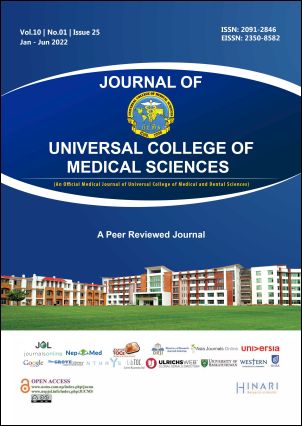Stroke Related Anxiety and Secondary Stroke Prevention Practices among Stroke Survivors
DOI:
https://doi.org/10.3126/jucms.v10i01.47243Keywords:
Anxiety, Prevention practices, Secondary stroke, StrokeAbstract
INTRODUCTION
Stroke is a leading cause of death and permanent disability worldwide. A secondary stroke, also known as a recurrent stroke, is one which occurs 24 hours or more after a primary stroke. The objective of this study was to find out the stroke related anxiety, knowledge related to the risk factors of stroke and practices among stroke survivors to prevent secondary stroke.
MATERIAL AND METHODS
Descriptive cross-sectional study was conducted to find out stroke related anxiety and secondary stroke prevention practices among 76 purposively selected stroke survivors. Semi- structured interview schedule and Hospital Anxiety and Depression Scale (HADS) were used to collect data. Descriptive statistics (frequency and percentage) were used with SPSS version 20.0 for data analysis.
RESULTS
The findings of the study showed that out of 76 stroke survivors, 13.16% had borderline anxiety and 11.84 % were abnormal cases of anxiety. Knowledge on risk factors of secondary stroke as old age (94.74%), physical inactivity (55.26%), smoking (60.53%), excessive alcohol consumption (63.16%) and hypertension (92.11%). Poor practices were found regarding secondary stroke prevention such as monitoring blood pressure regularly (26.53%), regular exercise (40.79%), nearly half had not reduced alcohol intake (44.19%) and had not quit smoking (48.15%).
CONCLUSION
Findings of the study showed presence of stroke related anxiety among stroke survivors and poor secondary stroke prevention practices. These data will be helpful for concerned authority to focus on management of post stroke anxiety. It is recommended to concerned authority to conduct awareness program on secondary stroke prevention practices.
Downloads
Downloads
Published
How to Cite
Issue
Section
License
Copyright (c) 2022 Journal of Universal College of Medical Sciences

This work is licensed under a Creative Commons Attribution-NonCommercial 4.0 International License.
Authors have to give the following undertakings along with their article:
- I/we declare that this article is original and has not been submitted to another journal for publication.
- I/we declare that I/we surrender all the rights to the editor of the journal and if published will be the property of the journal and we will not publish it anywhere else, in full or part, without the permission of the Chief Editor.
- Institutional ethical and research committee clearance certificate from the institution where work/research was done, is required to be submitted.
- Articles in the Journal are Open Access articles published under the Creative Commons CC BY-NC License (https://creativecommons.org/licenses/by-nc/4.0/)
- This license permits use, distribution and reproduction in any medium, provided the original work is properly cited, and it is not used for commercial purposes.




